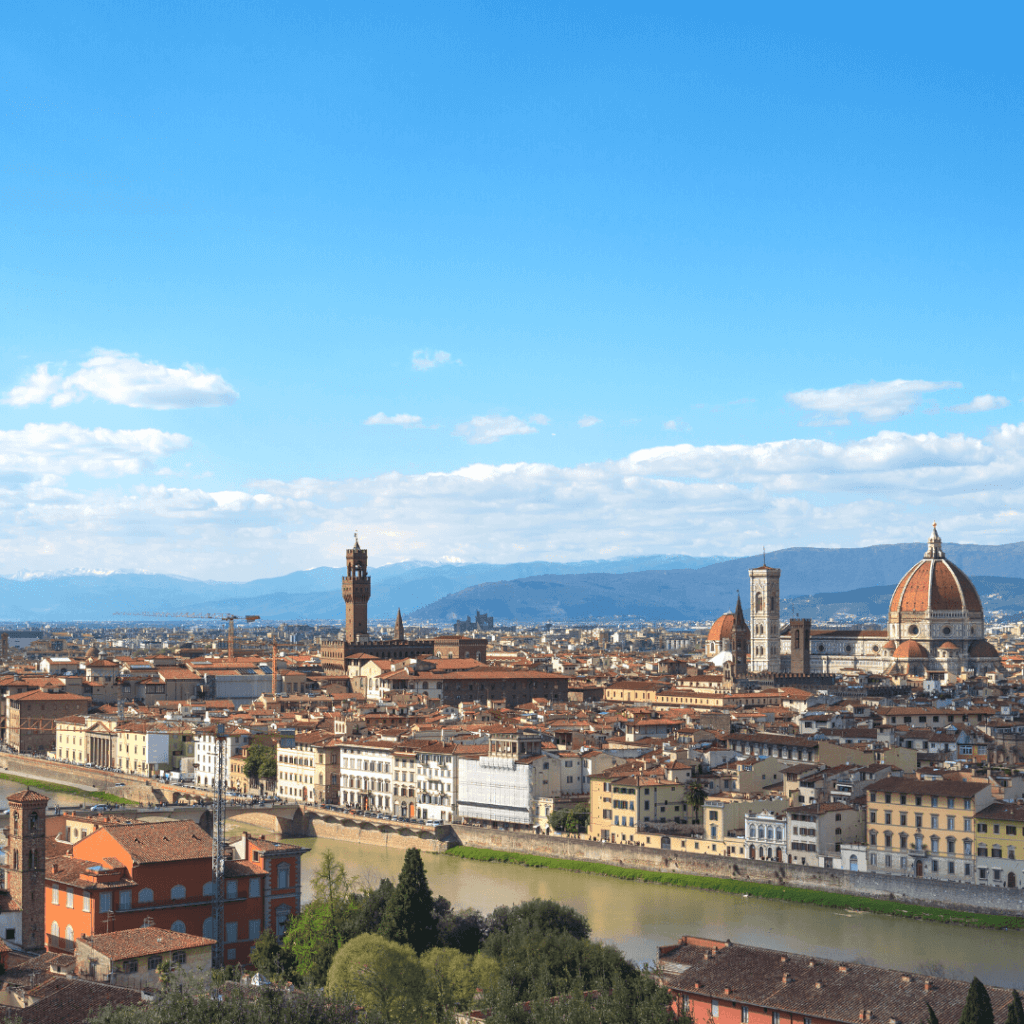
Florence Architecture Through the Centuries: A Comprehensive Overview
April 14, 2025
Step into Florence’s vibrant past where every stone tells a story. From intricate Gothic details to breathtaking Renaissance elegance, this comprehensive guide invites you to explore the city’s architectural marvels and rich cultural legacy.
Keep reading to learn about the major architectural periods that contributed to Florence’s cityscape, including many buildings and attractions that are likely already on your must-see list.
Table of Contents
ToggleFlorence Architecture: The Medieval Period
In Florence, medieval architecture encompasses two primary styles: Romanesque and Gothic. There’s a great deal of debate about when the Medieval period began (you may see anywhere from the 6th through the 11th centuries), but regardless it’s a long stylistic era—at least four centuries and possibly as much as ten.
Romanesque Splendor in Historical Architecture Florence
Romanesque architecture thrived in Florence during the 10th to the early 12th centuries. As the name implies, it drew inspiration from the revered Ancient Roman monuments, paying homage to their familiar style of design. These designs nearly always included large columns and rounded arches over windows and doors. The structures themselves also tended to be huge in scale, with extremely thick walls and high, arched arcades.
The basilica of San Miniato al Monte is a great example of Romanesque architecture in Florence, with its façade of columns and rounded arches. The grand arches continue inside the nave, with smaller ones in the crypt below.
Gothic Grandeur: Elevating Florence Art and Architecture
During the latter part of the Medieval era, the Gothic style took center stage, originally originating in France (perhaps you’ve seen the magnificent Sainte-Chapelle in Paris, which is a prime example of this style). However, it quickly gained popularity and spread throughout Europe from the late 12th to the 16th centuries.
The Gothic style is characterized by graceful, pointed arches and—contrary to the darker connotations of the word “goth” today—an increase in the number and size of windows for more well-lit interiors. Most high ceilings of Gothic buildings reveal what made those taller windows possible: rib vaults.
These distributed weight more evenly than a Romanesque arched vault, which allowed Gothic architects to construct taller and taller buildings. Gothic columns were sometimes solid cylinders, like Romanesque columns, but by the late Gothic period many columns were also clustered as extensions from the rib vaults above.
Fun fact: Venetian architecture also showcases the Gothic style.
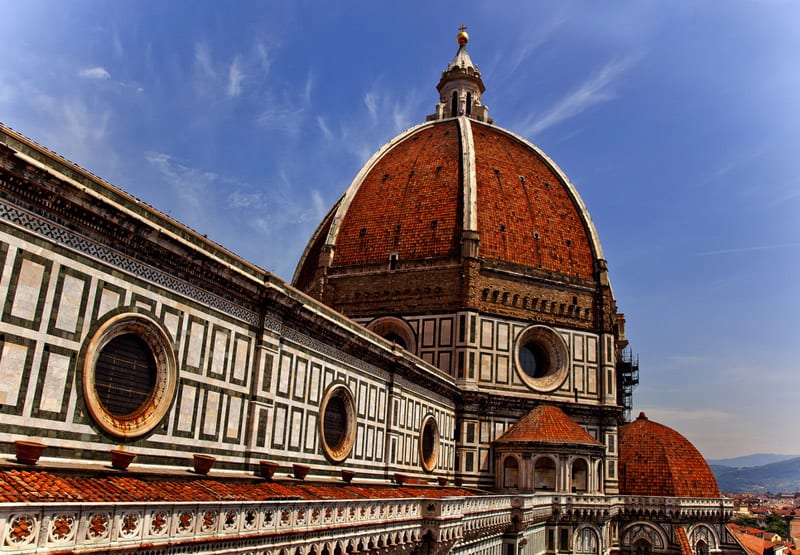
The overall structure of Florence’s Santa Maria del Fiore Cathedral, better known as the Duomo, is a beautiful example of Gothic architecture. The nave features a high ceiling with four-part rib vaults and pointed arches atop clustered columns. The dome itself and the multicolored façade were both added later.
Florence Architecture: The Renaissance Period
In Florence, the Renaissance period can also be categorized into distinct architectural styles: Early Renaissance, High Renaissance, and Late Renaissance (also known as Mannerist). Although this period lasted for only about a century, it proved to be remarkably fruitful, giving rise to styles that have stood the test of time. Overall, Renaissance architects favored symmetry and mathematical order.
Early Renaissance: Birth of a New Era in Florence Architecture
Since Florence is traditionally thought of as the birthplace of the Renaissance, it should come as no surprise that the style of Renaissance architecture got its start in the city. In fact, Filippo Brunelleschi, the celebrated Florentine architect who designed the beautiful dome on the city’s cathedral, is generally credited with introducing the style.
The Early Renaissance period began with Brunelleschi in the early 15th century. He incorporated Gothic design elements into the cathedral’s dome, but it was the soaring structure that was revolutionary at the time.
Brunelleschi took notes (and samples) in Rome’s Pantheon in order to erect a massive dome in Florence without needing a keystone or buttresses. He designed an egg-shaped exterior dome over a rounder interior dome, with vertical ribs helping to distribute the considerable weight. This egg shape would eventually be a dome silhouette copied all over the world.
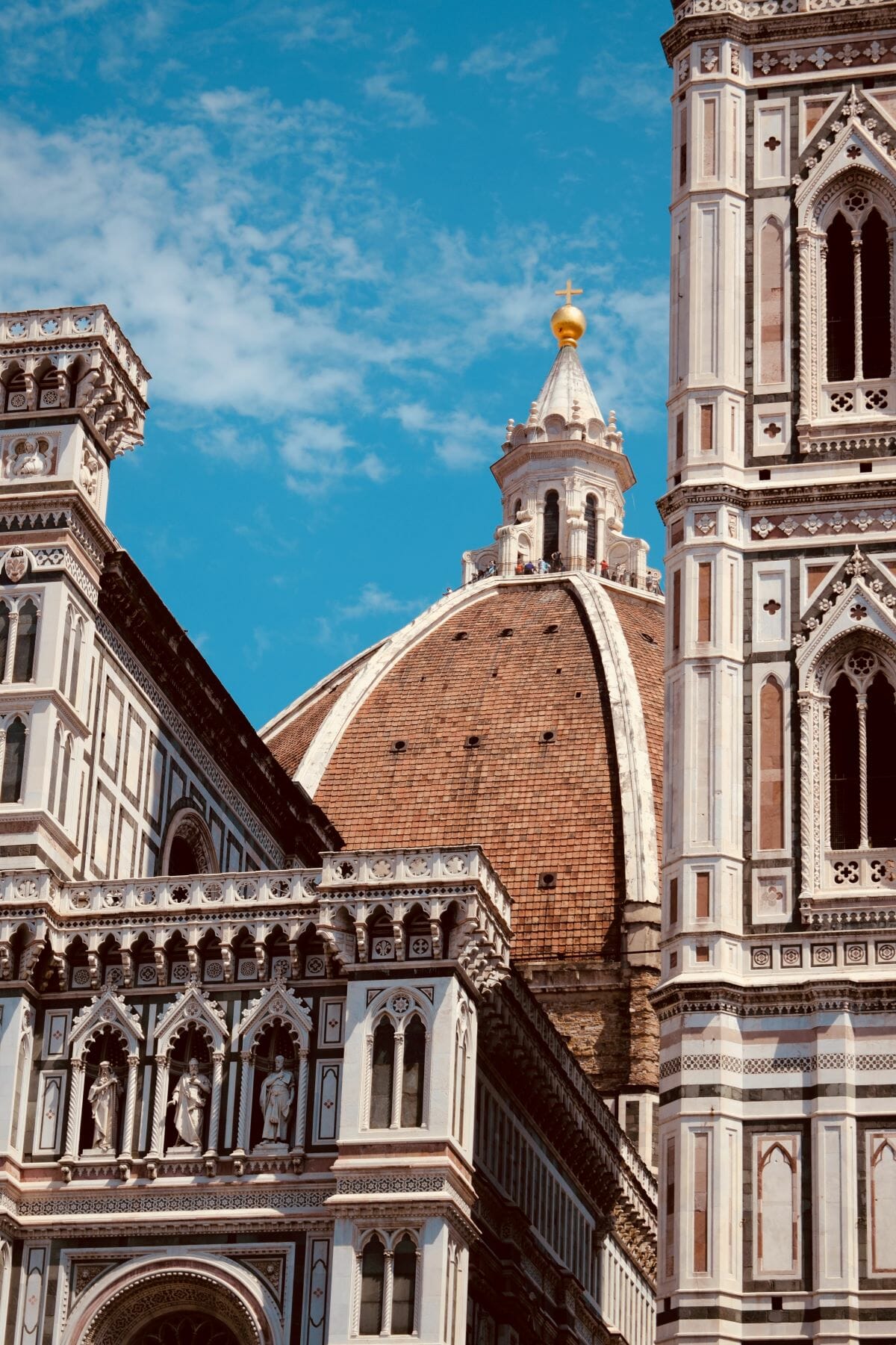
Among Filippo Brunelleschi’s numerous accomplishments, one of his most famous is crafting for the dome of Florence’s Duomo. Photo credit: Antônia Felipe
High Renaissance: Symmetry and Splendor in Florence Art and Architecture
The High Renaissance ran roughly from the late 15th century to the early 16th century, a rich artistic period during which the likes of Michelangelo, Leonardo da Vinci, and Raphael also thrived.
Architecturally speaking, most buildings were still all about symmetry and order, but some were starting to feature elements that were purely decorative—such as colorful façades and exterior niches for statues. The gorgeous upper façade on the Santa Maria Novella basilica is an example of this.
The church itself and much of the lower façade were built in the Romanesque era, but the intricate designs in green and white marble at the top of the façade were added in the late 15th century.
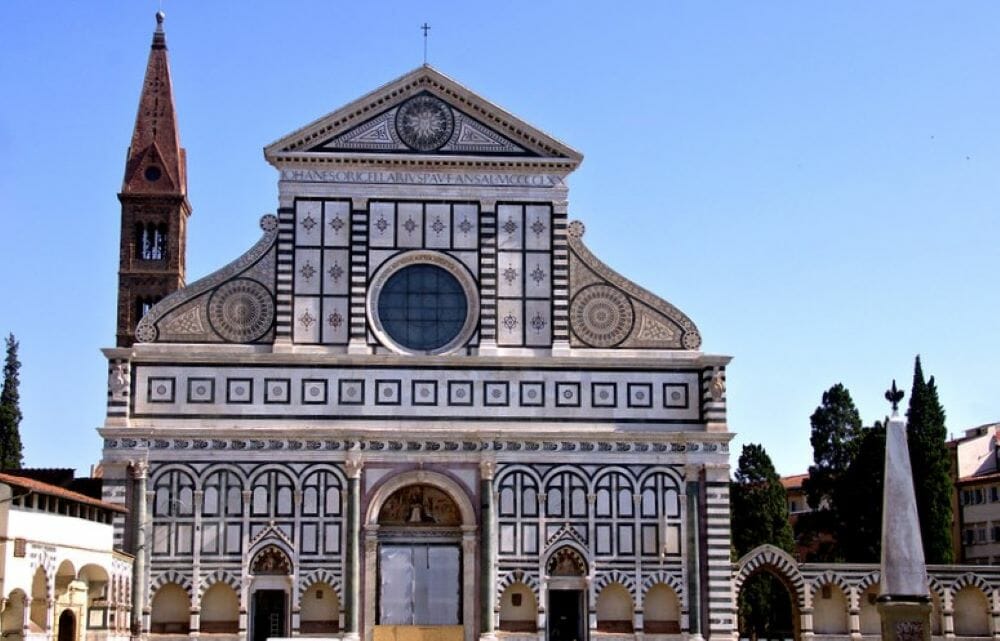
The upper façade of the Santa Maria Novella basilica stands as a shining illustration of this artistic evolution during the High Renaissance period. Photo credit: Jose Javier Martin Espartosa
Late Renaissance/Mannerist: Reinventing the Florence Architecture Guide
The end of the Renaissance, from the early to late 16th century, is sometimes known as Mannerist. The name came from the idea that artists at the time were trying to improve upon the art of prior periods in a new “maniera,” Italian for “style.”
Mannerist architecture often included unexpected features that would have felt particularly surprising at a time when people had gotten used to the order and symmetry of the High Renaissance.
One of the earliest examples of Mannerist architecture is the Laurentian Library next to the Basilica of San Lorenzo. It was designed by Michelangelo, who played with oversized Romanesque elements to make smaller spaces feel incredibly grand—like the huge staircase and paired columns in the vestibule.
Florence Architecture: The Baroque Period
The Baroque period spans the late 16th century through the 18th century—and, like Renaissance architecture, it started in Italy. This incredibly fancy style originated in Rome, where architects were creating increasingly decorative designs for the Catholic Church in an effort to draw attention away from the Protestant Reformation.
Building on the unexpected elements Mannerists included in their designs, Baroque architects added a great deal more glitz and sparkle to familiar features (such as domes and columns), with ornate plaster carvings and lots of gold leaf. They also put trompe-l’œil paintings on ceilings to make interiors more grandiose than the physical space allowed.
There’s nothing understated about Baroque design. In fact, this style is so distinct (and, once you know what to look for, pretty easy to identify) that the word “baroque” is used as a common synonym for “ornate” to this day.
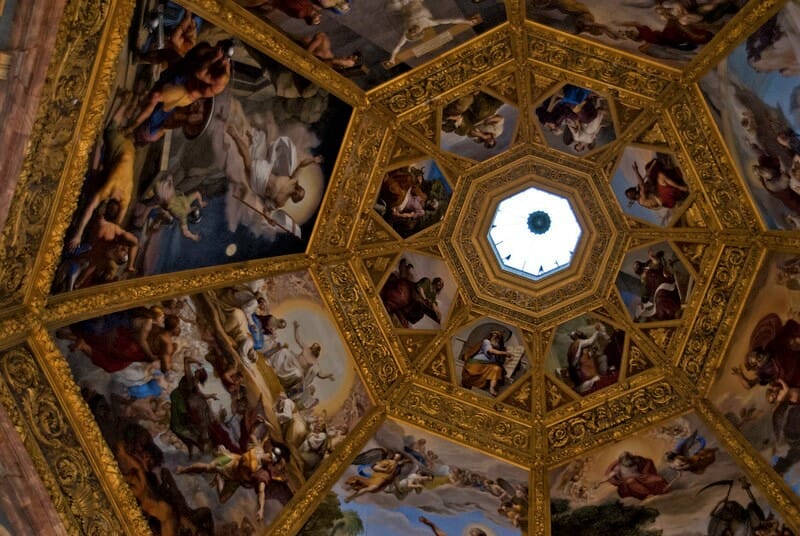
A great example of Baroque architecture in Florence is seen inside the Cappella dei Principi, often called the Medici Chapel, next to the Basilica of San Lorenzo. Photo credit: Kayleigh Mifsud
Though Florence wasn’t the birthplace of the Baroque, there are still a few nice examples of Baroque architecture in the Tuscan capital. Perhaps the finest is the Cappella dei Principi, often called the Medici Chapel, next to the Basilica of San Lorenzo.
The chapel, begun in 1604, is octagonal with a soaring dome that (from the outside) looks quite like the dome over Florence’s cathedral. Unlike the white or gray interior walls of many churches and chapels, the walls and floor of the Cappella dei Principi are almost completely covered with pieces of marble in several different colors. There are trompe-l’œil paintings on the ceiling’s panels, decorative carvings and precious stones on the walls, and shiny bronze statues at each of the (empty) sarcophagi.
Florence Architecture: The 19th Century
From the late 18th century through the 19th century, there were several architectural styles around Italy—some of which can be seen in Florence.
Neoclassical, for instance, saw the pendulum swing away from the elaborateness of the Baroque to the classical elements of Ancient Roman and Ancient Greek buildings. The focus here was on clean lines and functional spaces. Florence’s Piazza della Repubblica has Neoclassical features, including the giant arch built into one of the structures surrounding the square.
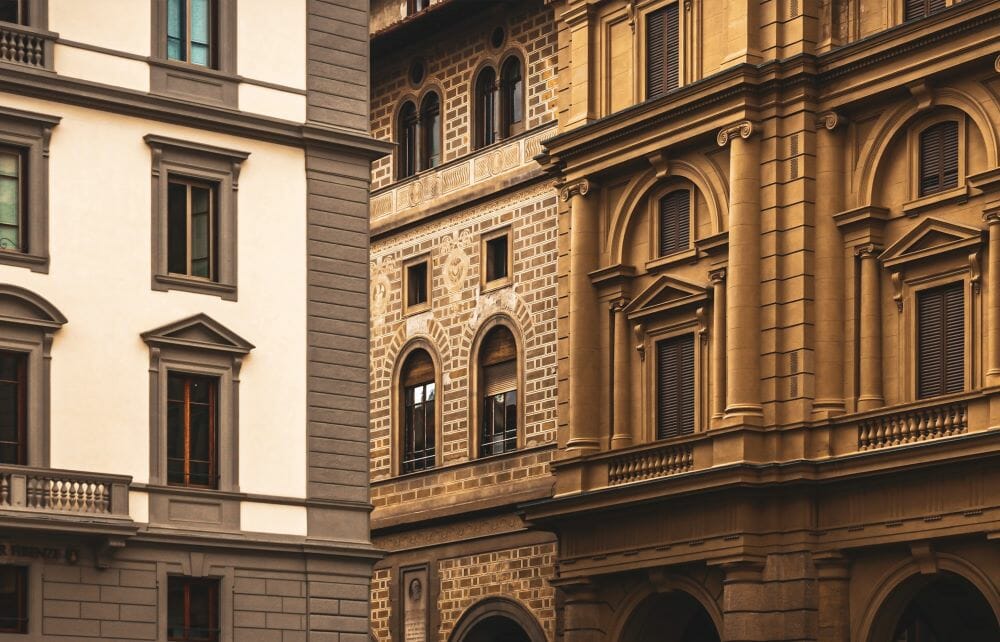
Florence’s Piazza della Repubblica displays beautiful Neoclassical features. Photo credit: Ana Bórquez
Art Nouveau (which started in the 19th and continued into the 20th century) got a uniquely Italian twist, known as Liberty style. In this context, the pendulum swung in the opposite direction, favoring more curved lines and embracing the use of decorative elements for the sake of adornment itself. The Casa-Galleria Vichi on Borgo Ognissanti is an excellent example of the Liberty style in Florence.
20th Century: Redefining Tradition in Florence Architecture
As much as we love Florence’s historic buildings, there are also fine examples of more modern and contemporary architectural styles in the city.
When you arrive by train in Florence, you’ll likely do so in one of the city’s best examples of Italian Rationalism: the Santa Maria Novella train station. The current station, which opened in 1934, resulted from a design competition held two years earlier, with Mussolini personally selecting the winning design.
The building moved away from the decorative flourishes of the Liberty style and toward hard angles and straight lines again.
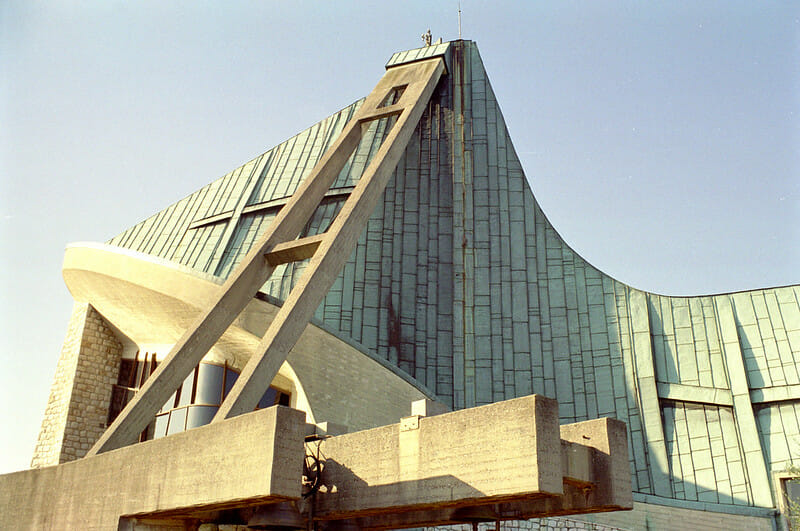
Giovanni Michelucci’s peculiar church that resembles a tent, located near Florence. Photo credit: Doctor Casino
The architect who designed Florence’s train station, Giovanni Michelucci, is also responsible for one of the area’s most famous post-WWII structures: the striking Church of San Giovanni Battista in nearby Campi Bisenzio. The church, built in the early 1960s, is also sometimes called the “Chiesa of the Autostrada,” or “Church of the Freeway,” because of its proximity to two major highways. It resembles a tent from the outside, with a great curving roof that’s covered in copper tiles that have turned green.
Florence’s architectural history FAQs
What time periods influenced Florence’s architecture?
Florence’s architecture reflects influences from medieval Gothic innovations to the refined artistry of the Renaissance era.
How does Florence’s architecture narrate the city’s history?
Every building, with its unique design elements, contributes to the narrative of Florence’s evolution from ancient structures to modern masterpieces.
What are the must-see architectural landmarks in Florence?
Essential visits include the Duomo, Basilica of San Miniato al Monte, Santa Maria Novella, and the Medici Chapel, among others.
How can visitors explore Florence’s architectural heritage?
Numerous guided tours, museum exhibitions, and digital archives provide a deeper look into Florence’s rich architectural history.
What role does art play in Florence’s architecture?
Art and architecture are inseparable in Florence, with many buildings featuring detailed artistic embellishments that celebrate its cultural legacy.
Are there modern interpretations of Florence’s historical styles?
Yes, modern designs in Florence, such as the rationalist train station and contemporary religious structures, reflect a blend of past and present.
How has Renaissance architecture influenced modern design trends?
Renaissance principles of symmetry and proportion continue to inspire contemporary design, bridging historical artistry with modern functionality.
Update notice: April 14, 2025
Ready to step into Florence’s stunning storybook of architecture? From the towering Duomo to the intricate details of the Renaissance palaces, Florence is a city where every corner whispers tales of artistry and innovation. Immerse yourself in history, art, and architecture on our carefully crafted Full Day Florence Tour!
by Jessica Spiegel
View more by Jessica ›Book a Tour

Pristine Sistine - The Chapel at its Best
€89
1794 reviews

Premium Colosseum Tour with Roman Forum Palatine Hill
€56
850 reviews

Pasta-Making Class: Cook, Dine Drink Wine with a Local Chef
€64
121 reviews

Crypts, Bones Catacombs: Underground Tour of Rome
€69
401 reviews

VIP Doge's Palace Secret Passages Tour
€79
18 reviews

Legendary Venice: St. Mark's Basilica, Terrace Doge's Palace
€69
286 reviews









